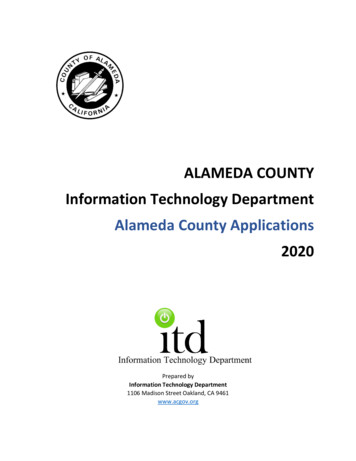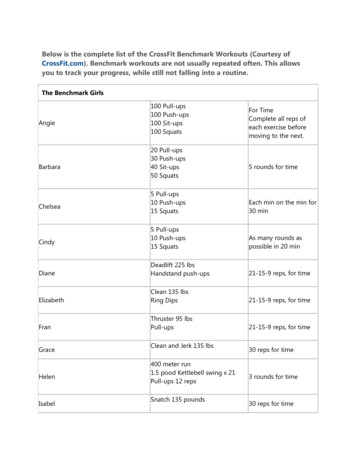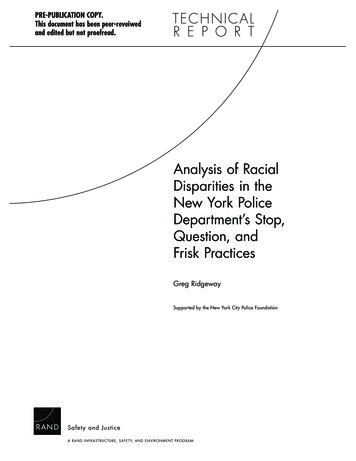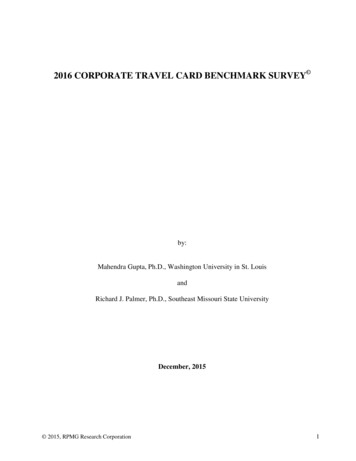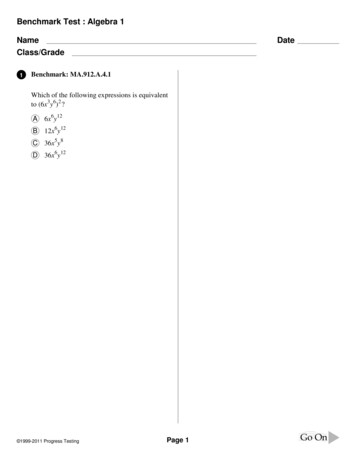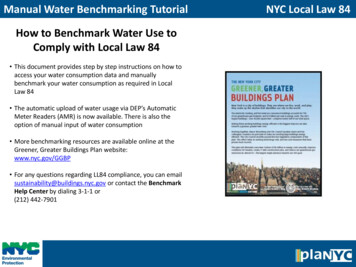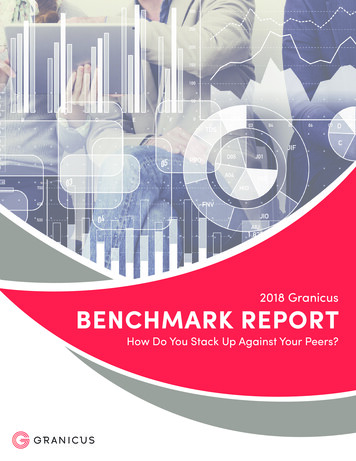
Transcription
2018 GranicusBENCHMARK REPORTHow Do You Stack Up Against Your Peers?
Table of ContentsOverview03Key Takeaways06Email AnalysisEmail Metric 1: Open Rate07Email Metric 2: Click Rate09Email Metric 3: Engagement Rate11Email Metric 4: Subscription Per Subscriber13Email Metric 5: Overlay Impact15Website AnalysisWebsite Benchmark 1: Device Usage17Website Benchmark 2: Entrance Page by Device19Website Benchmark 3: Traffic Sources21Social Media AnalysisSocial Media: Click Rate23Conclusion25Engagement Metrics by Vertical26granicus.com2
OverviewFor every digital message opened, website navigation tracked, or social mediafollower added, there is one question that inevitably comes up when reviewingmetrics: How do my numbers compare to my peers’?In today’s digital age, there is no need for blind guessing. Metrics are more plentifulthan ever and, in this year’s Engagement Benchmark Report, we dive deep into thereporting data of the top three tools used by governments to communicate withcitizens: email, websites and social media.With 85 percent of adults still sending and reading email every day, email is animportant platform to monitor regularly. And overall, across all levels of government,email engagement is on the rise. The data in this year’s Benchmark Report mirrors theincreasing levels of civic engagement happening online – especially among youngergenerations, according to Pew Research.While this report focuses primarily on email metrics, government websites are also atop tool for connecting and engaging with citizens. In fact, 91 percent of governmentleaders identify their website as extremely or very important to their communicationsstrategy.And last but not least, social media remains a popular outlet for governments toconnect with citizens (and vice versa). This year we’ve added a section that revealswhich social media platform is most linked within email, and which ones garner themost attention (in the form of clicks) from citizens.While communications strategies can be measured, they also are always changing.So even if you focus on just one of the three digital channels covered in this report,you’re guaranteed to come away with a sense of how you’re doing compared to yourpeers and how you can constantly improve. Check the end of each section for tips andtricks to sharpen your digital strategy for ongoing success.granicus.com3
About the DataThe metrics in this report are based on annual data of the 4,000 U.S. federal, state, local andtransit (SLT), and U.K. organizations that use Granicus’ solutions. For email and social metrics,figures represent the median. For website metrics, figures represent the average. A single, overallfigure is provided for each U.K. metric. Benchmark metrics measured by vertical (or subsector)can be viewed in the addendum to the report.Primary Email Metrics and DefinitionsThe primary metrics assessed in this year’s Benchmark Report are open rate, click rate,engagement rate, subscriptions per subscriber and overlay impact. Here are definitions of thesefive primary metrics:OPEN RATEThe number of recipients who opened an email compared to the number who received it.CLICK RATEThe number of recipients who clicked on an email compared to the total number who received it.ENGAGEMENT RATEThe number of unique email recipients who opened an email or clicked on a link in an email overa 90-day period, divided by the total number of email recipients who received an email duringthat time period.SUBSCRIPTION-PER-SUBSCRIBERThe number of topics for which an individual has signed up to receive email updates, calculatedby dividing total subscriptions by total subscribers.OVERLAY IMPACTThe total number of overlay subscribers divided by the total number of subscribers from directsignups.granicus.com4
Primary Website Metrics and DefinitionsA government website is the digital front door for your community. With more citizens looking tocomplete tasks and engage with their government online it’s important to make the most of this digitalpresence. Recent research provides valuable insight into how citizens find government websites, whatdevices they typically use, and what pages they visit. This data helps us optimize citizen experiencesand drive even more website traffic.The metrics in this report are based on annual Google Analytics website data (May 2017-May 2018)for 88 Granicus U.S. website clients (67 percent cities, 33 percent counties). The purpose of this reportis to illustrate how users consume and experience local government websites through an aggregationof various metrics, as well as to provide benchmarks and best practices related to these metrics.DEVICE USAGEThe percentage of visitors who access a website from their desktop, smartphone or tablet.ENTRANCE PAGE BY DEVICEThe initial page a user lands on when they visit your website, analyzed by device used (desktop,smartphone, tablet).TRAFFIC SOURCESHow people find your website. Common sources include: organic search, direct links, referrals,and social media.Comparing SectorsWhen using benchmarking data to compare your organization to your peers in government, it ishelpful to understand the larger context of email metrics – particularly those in the private andnonprofit sectors. It’s a question that Granicus gets often.The great news for public sector communications professionals is that government regularly meetsor exceeds the metric benchmarks among all sectors. For instance, Granicus found an overall openrate for government email messages of 21 percent. Meanwhile, the private sector has roughly an 18percent open rate, according to IBM’s 2018 Marketing Benchmark Report. And the nonprofit sector’sopen rate comes in at around 16 percent, according to Blackbaud’s 2017 Luminate BenchmarkReport. It’s always good to recognize these figures exist in private and nonprofit sector reports,but government is different - from the nature of information sent to citizens to how success ismeasured. At Granicus, we believe this is why the public sector deserves its own set of benchmarks.21%Public Sector Open Rategranicus.com18%Private Sector Open Rate16%Non-Profit Open Rate5
At a Glance:Key Takeaways and HighlightsTHE DATAMeasured fromJune 2017 - June2018From 4,000governmentorganizations1.6 million emailssent to citizensubscribersActivity among185 million citizensubscribersEMAIL METRICSEngagementRateOpen RateClick RateSubscription %2.9%2.0144%201653%21%2.9%2.5174%EMAIL METRICS TRENDS47%Engagement Ratesare trending up21%150%Open Rates remain flatthe past 3 yearshigher when comparingtop 20% to medianSOCIAL MEDIATwitter links were sharedmost in email bulletinsYouTube links were clickedmost in email bulletinsWEBSITEtraffic frommobile45%traffic fromorganic search63%0%granicus.com10%20%30%40%50%60%6
Email Metric 1:Open RateThe number of recipients who opened an email compared to the number who received it.Open rate seems like a straightforward measurement, but it’s not always comprehensive. Openrates can sometimes be affected by images not being downloaded in emails (Many stats aretracked like this using pixels embedded in emails.) But when it works, it’s best used to understandthe effectiveness of similar messaging over time to determine which approach works best. Themost obvious driver of a poor—or excellent—open rate is the subject line. It should have a “hook”that captures the attention of the audience. Other factors impacting open rates include senderinformation, time of day and quality of the subscription list.Median41%40%31%31%30%20%Top 2%31%STATE & LOCALUNITED KINGDOMPast Metrics201820172016MEDIAN21%21%21%TOP 20%31%32%31%When developing your strategy, it’s important to identify whether or not open rate is a key factor youneed to measure for success. A large percentage of information sent from public sector organizationscan be consumed without being opened. For example, weather alerts or emergency notificationscan be conveyed in the subject line like “Snow Emergency Declared in St. Paul.” Your message iscommunicated, and it’s likely your audience can act without a high open rate.To find your open rate in the GovDelivery Communications Cloud, go to‘Sent Bulletins’ in your account, then ‘View Report’ of the bulletin.granicus.com7
Example of an Effective Bulletin for Open RateWHY WE LOVE ITOne way to increase open rates is topersonalize your email bulletin as muchas possible. In the example above fromGedling Borough Council in the U.K., thefirst name of the email subscriber is in boththe subject line and the body of the email.These factors led to a 69 percent open rateof this bulletin. In addition to high openrates, Gedling Borough Council has seengreat success in reducing calls to their callcenter by sending more effective emails.Read more in this success story.Tips for Improving Your Open RateKEEP SUBJECT LINES FRESHThe subject line is the first thing a person sees when a message arrives in their inbox so makesure you’re putting your best foot forward. That means keeping your subject line short and simple(preferably under 54 characters) as well as teasing why the reader should open it. That can bedone by offering need-to-know information or events that are happening. For example, “Tips forpreventing the flu” or “Are you attending the city picnic tomorrow?”.DON’T INUNDATE THE AUDIENCEThe average person gets hundreds of emails every day. If possible, don’t clutter their inbox withexcessive numbers of messages as this can overwhelm them and drive down your open rate.Instead, consider bundling non-critical messages into weekly or monthly roundups.granicus.com8
Email Metric 2:Click RateThe number of recipients who clicked on an email compared to the total number who received it.Click rate indicates the number of recipients who click on something within your email afteropening it compared to the total number of people who received the email. Because youknow someone who has clicked something already opened the email, this can make it a morerevealing metric than open rate for certain types of emails. For instance, if you want citizens totake action, paying attention to click rate can tell you which messages are the most likely to spurpeople to act. But many public sector emails are solely informational, such as benefit enrollmentnotifications and calendar reminders. If these are the types of messages you are sending, it willmake click rate a less-reliable indicator that you’re reaching the right audience.MedianTop L14%23%FEDERAL4.0%2.0%22%31%STATE & LOCALUNITED KINGDOMPast Metrics201820172016MEDIAN2.0%2.9%2.9%TOP 20%5.0%6.3%6.8%Click rates fell slightly across the board in 2018, but these changes were negligible andcan be attributed to minor changes in a few accounts. Notable, however, is the gapbetween the most successful organizations and the rest: The top 20 percent of accountssaw click rates 150 percent higher than the median.To find your click rate in the GovDelivery Communications Cloud, go to ‘SentBulletins’ in your account, then ‘View Report’ of the bulletin.granicus.com9
Example of an Effective Bulletin for Click RateWHY WE LOVE ITThe Minnesota Department of NaturalResources (DNR) sent this bulletin toincrease subscriptions for its deermanagement newsletter. While most bestpractices point to including a single call toaction for your audience to click, it mightbe wise to A/B test including an additionalcall to action like the Minnesota DNR didhere to give your audience another optionif your primary CTA isn’t resonating.Tips for Improving Your Click RateREPEAT, REPEAT, REPEATDon’t be afraid to offer your reader the option to click multiple times as they read – at the start,in the middle and at the end of your digital message.TEST CALLS TO ACTIONHere’s another chance to use A/B testing. If you find that your click rates aren’t what you expect,try adjusting how you call attention to the action you want citizens to take. Maybe it’s tweakingthe language or changing the color of the button they click. Try this a few different ways to seewhat sticks.granicus.com10
Email Metric 3:Engagement RateThe number of active unique email recipients measured over 90 days.Engagement rate is perhaps the most important stat to measure and monitor communicationsconsistently. This rate is calculated by taking the number of unique email recipients who openan email or click on a link in an email over a 90-day period, and labeling those individuals as“engaged.” That number is then divided by the total number of email recipients during that timeperiod. If the rate holds steady or increases while the total reach grows, an organization typicallysees increasingly impactful digital communications over time.MedianTop 20%61%52%61%68%47%38%47%55%OVERALLFEDERALSTATE & LOCALUNITED KINGDOMPast Metrics201820172016MEDIAN47%45%53%TOP 20%61%60%65%Median engagement rates ticked up slightly in 2018 to 47 percent, but they’re still below the2016 rate of 53 percent. This was a trend across the board, even with the highest-performingorganizations; the top 20 percent saw their engagement rate rise to 61 percent in 2018 from 60percent in 2017, but that still fell below 2016’s 65 percent rate.To find your engagement rate in the GovDelivery Communications Cloud,go to Reports Account Performance Report.granicus.com11
Example of an Effective Bulletin for Engagement RateWHY WE LOVE ITThe District of Columbia has anengagement rate of 52.4 percent, whichis a reflection of highly actionable andtimely bulletins sent over the past threemonths. This bulletin, just one exampleof the information the District sends to itsaudience, has a number of aspects thatlead to strong engagement rates including:a time-sensitive subject line (special alert)and notice about an upcoming event,content that is targeted toward a specificaudience (housing providers), and relevantcalls to action.Tips for Improving Your Engagement RateTHREE “TS”: TARGETED, TIMING AND TONEA strong engagement rate isn’t magic. When sending a message, you should always ask yourselfseveral questions: Am I sending this email to everyone on my subscription list, or have I targetedit to an audience that truly cares about the content? Am I sending this message at the right timefor this targeted audience? Is the tone that I am setting in the message one that matches theaudience and compels them to act?TEST WHAT WORKSIt sometimes takes a while to figure out exactly what your audience wants. That’s why it’simportant to use A/B testing functionality, like that in the GovDelivery Communication Cloud’sAdvanced Package. This gives you the ability to send two emails that aren’t quite alike (perhapsa different subject line or call to action) to see which performs best. Even when you’ve crackedthe code to engagement, you should constantly be retesting to continually improve.granicus.com12
Email Metric 4:Subscriptions Per SubscriberThe number of topics subscribers signed up for divided by the total subscriptions by total subscribers.If your organization is savvy about its email marketing strategy, it will likely not have a singlesignup list for citizens, as this would mean that everyone would receive the same emails, evenif they’re not interested in them. For instance, a city may choose to offer lists for general cityhappenings, events at the park, road projects, city council meetings and the animal shelter.MedianOVERALLSTATE & LOCALFEDERAL2.82.13.9Top 20%UNITED KINGDOM1.92.45.03.35.9Past Metrics201820172016MEDIAN2.12.02.5TOP 20%3.93.94.9Freedom to make choices about what ends up in their inbox is key to ensuring citizens are gettingthe messages they want, when they want them. A way to check the effectiveness of the informationyour organization is putting out is by tracking subscriptions per subscriber. This is a way to seehow many different topics the average citizen is interested in on your account. This is calculated bytaking the total number of subscriptions and dividing it by your total subscriber count.To find your subscriptions per subscriber rate in the GovDeliveryCommunications Cloud, go to Reports Account Performance Report.granicus.com13
Example of a Strong Subscriber Sign UpWHY WE LOVE ITThe Nebraska Game and ParksCommission groups subscriber topicstogether by interest to encouragesubscribers to sign up for multiple subtopics. For newsletters that they want topromote, they’ve brought that topic upas “general interest” to get subscribers’attention who they might miss if it werefurther down the list.Tips for Improving your Subscriptions per SubscriberORGANIZE SUBSCRIPTION LISTS BY GROUPWhen bundling your subscription topics, it’s best to group them under broad headings. Forinstance, grouping a variety of sub-topics on benefits relating to veterans under “VeteransInformation” or sub-topics relating to college loans or grant programs under “Paying for College.”This way, people know what they’re signing up for and are more likely to sign up for more thanone topic.IDENTIFY OPPORTUNITIES FOR CROSS PROMOTIONConnect internally with other agencies to identify cross-promotional opportunities like events orexternal content that could include a pitch for signing up to one of your lists. These connectionsaren’t always obvious. For example, the State Department of Natural Resources and Departmentof Transportation may not appear to have a lot in common. But they could collaborate to crosspromote safe-driving tips during deer hunting season. In addition, the GovDelivery Network canautomatically recommend email lists to people during signup.granicus.com14
Email Metric 5:Overlay ImpactA small box that appears on a webpage that prompts an action.An overlay is a small window that will pop up over your website for first-time or repeat visitorsthat prompts them to act, whether that be downloading a report, registering for an event orsigning up for an email newsletter. Overlays are a fast and effective method of growing yourdigital audience. Worried that you might annoy a visitor to your website with repeated overlays?Don’t be. When setting up an overlay, you can adjust the settings so that once a visitor closes thebox, they never see it again.Median597%OVERALL162%866%FEDERALSTATE &LOCALTop 800%1000%Past Metrics201820172016MEDIAN162%144%174%TOP 20%597%1,564%584%Overlay impact rates increased across the board from 2017 to 2018, with the federal governmentseeing the largest increases (to 231 percent from 144 percent). Both state and local government,as well as the U.K., saw modest increases. But the trendline is somewhat down over the past threeyears, as no market has reached its median rate in 2016. Most notable is the large swing amongtop performers from year to year. In particular, 2017 saw a jump to 1,564 percent—well above the584 percent reported in 2016. But 2018’s numbers are back in line with 2016.To find your overlay impact in the GovDelivery Communications Cloud, go to Reports Account Performance Report Scroll down to Source of New Subscriptions.granicus.com15
Example of a Strong OverlayWHY WE LOVE ITThe Michigan Department of Health andHuman Services uses this overlay to increasepotential applicants for foster parents. Theoverlay uses strong, relatable imagery andoffers two forms of connecting - an emailaddress and a telephone number. For thisparticular program, a series of questionsare sent via text message to screen foreligibility, reducing the need for a telephonescreening. Click here to read more about theMichigan Department of Health and HumanServices.Tips for Improving Your Overlay ImpactTRY IT ON INTERNAL PAGES FIRSTIf your organization isn’t using an overlay now, you might want to consider implementing oneon your website’s most-visited pages. Implementing an overlay is an easy step toward greaterimpact and conversion of website visitors into action takers. Identify your most highly-visitedwebsite pages, and if you’re hesitant to start with your homepage, try testing an internal page tosee how it impacts bounce rates and subscriber signups.MAKE HOW TO CLOSE IT OBVIOUSOverlays should be simple, unobtrusive and appear right away when a visitor lands on a websitepage. Be sure to display just one step of the sign-up or action-taking process at a time, explain itclearly and make transitions seamless. It’s also important to provide an easy “opt out” for websitevisitors, so be sure to provide a clear way to exit the overlay.granicus.com16
Website Benchmark 1:Device UsageThe percentage of visitors who access a website from their desktop, smartphone or tablet.Device usage refers to the percentage of visitors who access a website from their desktop,smartphone or tablet. Our research reveals that about half the traffic to local governmentwebsites comes from a mobile device – a trend that is expected to grow as citizens becomeincreasingly mobile. In fact, since 2016, overall average use of a mobile device to accessgovernment websites has increased nearly 10 percent. We also found that a city website typicallyreceives more mobile traffic than a county website.Device usage is an important metric to monitor for several reasons. Most importantly, it showshow users are accessing your content so you can evaluate how experiences may differ by device.For example, by leveraging this data you can identify pages with higher mobile traffic andoptimize the experience for a mobile ile devices account for 45 percent of overall traffic. Government websites hashad nearly 10% more mobile traffic to their sites since 2016.granicus.com17
Mobile Homepage ExampleWHY WE LOVE ITThe Calcasieu Parish, Louisiana mobilehomepage provides an app-like lookand feel to enhance the user experience,without the need to download an app.This unique mobile homepage takes intoconsideration the top tasks and pagesvisited from mobile devices.Tips for Improving Your Mobile ExperiencesUSE THE LATEST TOOLSCitizens come to government websites to complete tasks – and they do so increasingly frommobile devices. To keep pace with citizen expectations and mobile growth trends, it’s imperativeto invest in mobile-responsive website design. Strive to make it as easy as possible for visitors tofind what they are looking for and easily complete tasks from any device.CREATE A UNIQUE MOBILE EXPERIENCETo make navigation more intuitive for mobile visitors, create an app-like interface for your mobilewebsite. Feature large tile icons, buttons and text, and quick links to top tasks completed bymobile users.granicus.com18
Website Benchmark 2:Website Entrance Page by DeviceAn entrance page is the initial page a user lands on when they visit your website.An entrance page is the initial page a user lands on when they visit your website. While somemight expect the homepage to be the primary entrance page, our research reveals that 65percent of visitors enter a government website on an interior page. The percentage is even higherfor mobile sessions at 78 percent. Understanding entrance page trends and performance metricscan help you better serve your citizens, optimize content beyond the homepage, and design amore effective website.Start by examining interior page performance. Identify the top trafficked interior pages todetermine which ones serve as entrance pages (or “mini homepages”). Then look at GoogleAnalytics to examine interior page metrics, like bounce rates and time spent on page, to 2%75%65%OVERALL45%90%INTERIOR PAGE30%78%MOBILE15%0%0%15%30%45%60%75%90%On government websites, 65 percent of people coming in areentering on an interior page.granicus.com19
Interior Page ExampleWHY WE LOVE ITTempe Center for the Arts originally hadseveral web pages within the city website,however, given heavy traffic to these interiorpages the center decided to build a separatepage within its website to help promoteactivities and draw attendance.The edgy design, imagery and advancedanimation pull visitors in and draw their eyesto key information. The custom calendarprominently features a “buy” button to drivemore revenue for the center.Tips for Improving Interior PagesMAKE DATA-DRIVEN DECISIONSUse Google Analytics to track trends in bounce rates, time spent on pages, traffic sources, pageviews and most highly trafficked entrance pages – and understand how to read the data tooptimize accordingly. For example, high bounce rates and short time on page aren’t necessarilybad. They could be a good thing for a task-oriented webpage whose goal is to empower users toquickly complete a task without having to search through multiple pages.DIFFERENTIATE HIGHLY TRAFFICKED INTERIOR PAGESCitizens who enter your website through an interior page may never see your actual homepage,so it’s imperative to treat your top interior pages as mini-homepages. Differentiate top interiorpages by using unique branding (imagery, font, colors) and navigation. For highly traffickedinterior pages, consider building a subsite with a unique URL to further differentiate it from themain agency website.granicus.com20
Website Benchmark 3:Traffic SourcesWebsite traffic sources are the origins through which people find your website.Website traffic sources are the origins through which people find your website. By far, organicsearch is the primary source of local government website traffic, accounting for more than60 percent – much of which lands directly on interior pages tied to specific search terms orkeywords. Interestingly, organic search is stronger on the city than the county level.Other top traffic sources include direct traffic (when someone types a URL directly into theirbrowser), which accounts for 25 percent of local government website visits. Referral traffic isdriven through links from other content sources and contributes 9 percent of overall governmentwebsite traffic. Social media sources account for 3 percent.By understanding traffic sources, government leaders can optimize pages that receive the mostvisits and use this data to help inform strategies to increase traffic.63%OVERALL AVERAGEORGANIC SEARCH60%COUNTY AVERAGEORGANIC SEARCH66%CITY AVERAGEORGANIC SEARCHOrganic search is the top source of traffic to government websites,accounting for 63% of all visits.granicus.com21
Top Traffic Sources to Government 03%0%10%20%30%40%50%60%70%Tips for Improving Website TrafficIDENTIFY AND OPTIMIZE KEYWORDSLeverage Google Keyword Planner to identify popular search terms and ensure your contentcontributors are trained on basic SEO best practices, such as including top ranking keywords inthe title, image alt tags, meta description and URL of each content piece. It helps to use a CMSthat offers built-in SEO prompts so good keyword tagging is part of the content creation process.CREATE ENGAGING SOCIAL CONTENTEverything from video and images to emojis can help content stand out and garner clicks in abusy social media feed. Social media should be used primarily for short content and importantupdates, with a clear call-to-action to drive visitors to the agency website for more information.granicus.com22
Social Media:Click RateRecipients who clicked on a social media link compared to the number of people who received it.Social media is an important pillar in your organization’s digital strategy, and emails are highlyeffective at driving engagement on your social accounts. The chart below is a representation ofthe click rate for the top social media accounts represented in email bulletins.OverallFederalState & 00.50.4FLICKR0.41.70.40.1LINKEDIN0.11.30.10.02Key TakeawaysYouTube was a massive performer. Across all levels of government, YouTube linkswere the most likely to be shared and clicked on - bringing the click rate to 2.3.Pinterest links were rarely included in email bulletins (representing only 1.3 percentof all social links) but received the second-highest click-per-link next to Youtube.Facebook largely tracked in line with its expected link-to-click ratio, but saw amuch higher social media click rate in federal bulletins.While YouTube links were the most likely to be clicked, Twitter links were the mostlikely to be shared in bulletins across all levels (bringing the ratio closer to 1:1).granicus.com23
Example of Good Use of Social Links in a BulletinWHY WE LOVE ITThe U.S. Department of Labor usedthis bulletin to increase its social mediafollowing for its new leader - a highlypersonalized way of reaching andconnecting with their audience. We lovethe bulletin because it uses colorful calls toaction with the appropriate social mediaicons, and also incorporates a video linkthat has an enticing and personalized title.Tips for Improving Social Media EngagementTEST SOCIAL MEDIA LINK PLACEMENTWhile the data suggests that most people click on YouTube links in email bulletins, it doesn’taccount for placement within an email. It’s likely that your Twitter, Facebook and LinkedIn linksare in the footer of your email, making them harder to find. As the U.S. Department of Labor doesin the bulletin above, try placing your social media links higher in your email to encourage moreclicks.PROMOTE SOCIAL ACCOUNTS OF YOUR LEADERSSocial media is all about authenticity and personalization; people feel more strongly connectedto other people on social platforms than to organizations. If it makes sense for you and is a partof your social strategy, try promoting the social accounts of the head of your organization in youremail bulletins. This will increase their followers, but will also put a face to your agency.granicus.com24
Concl
The metrics in this report are based on annual data of the 4,000 U.S. federal, state, local and transit (SLT), and U.K. organizations that use Granicus' solutions. For email and social metrics, . great success in reducing calls to their call center by sending more effective emails. Read more in this success story. granicus.com 9
